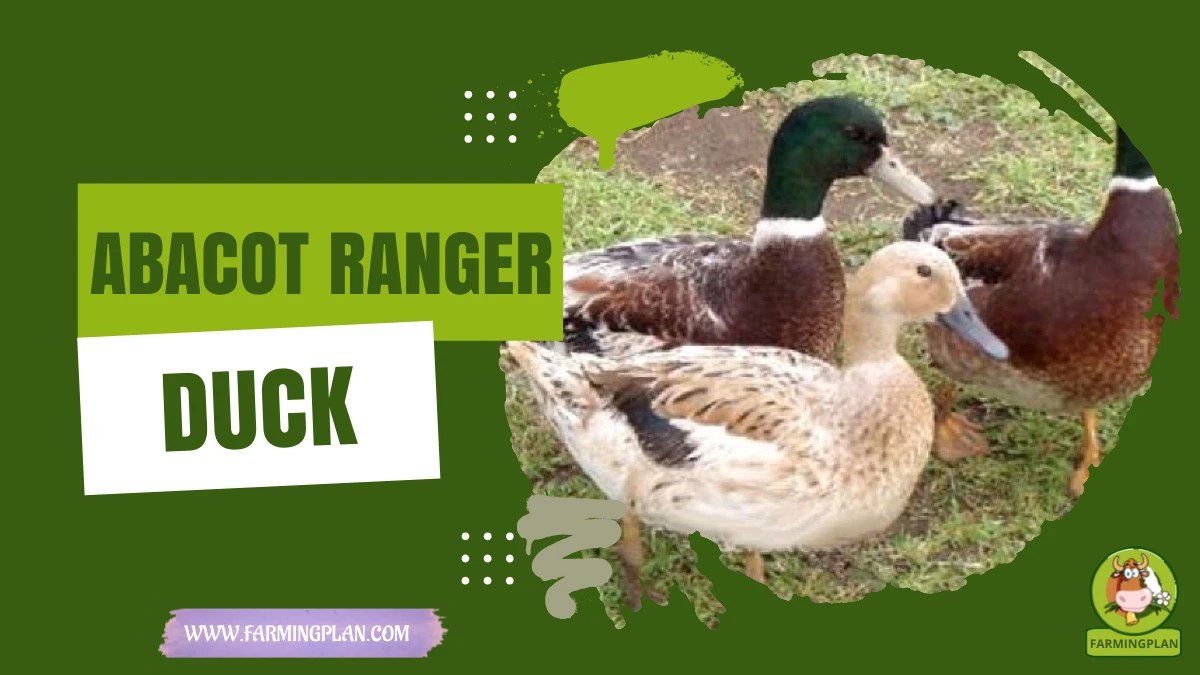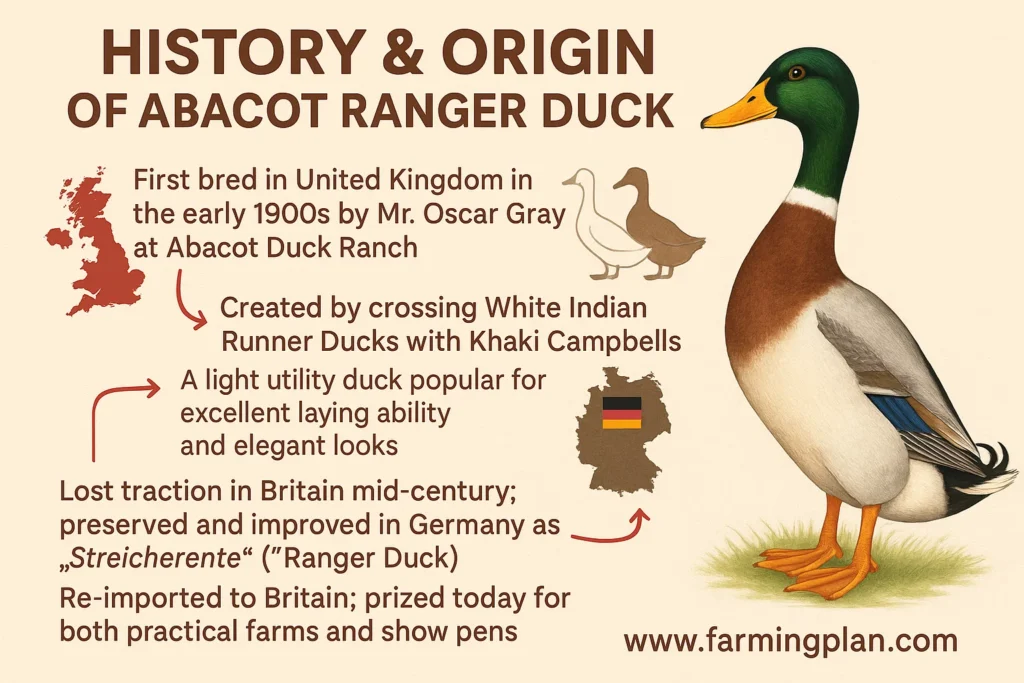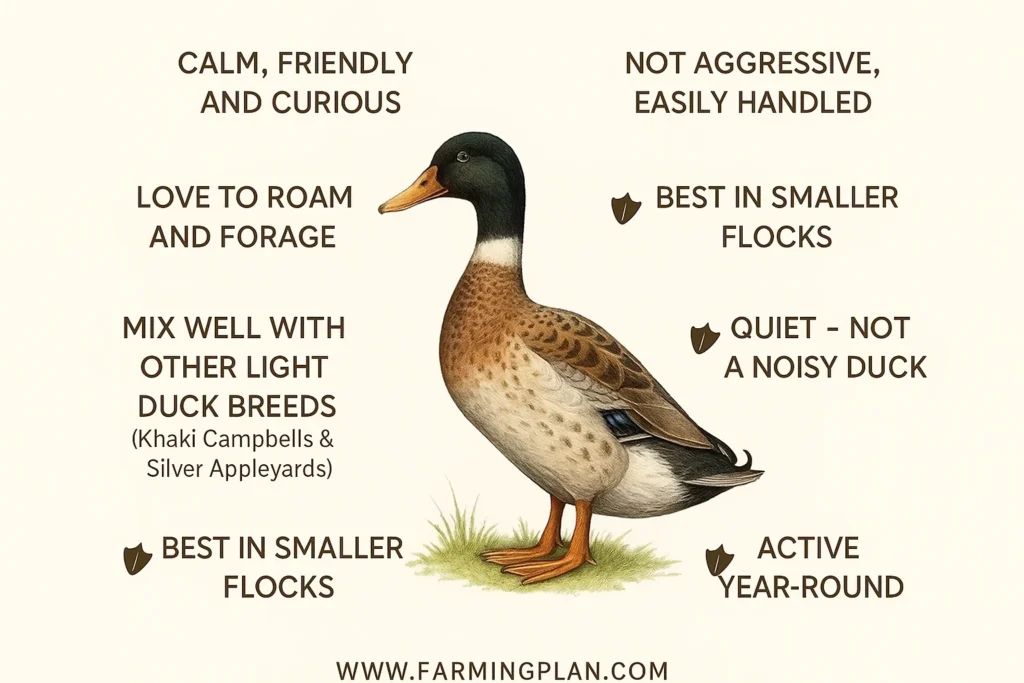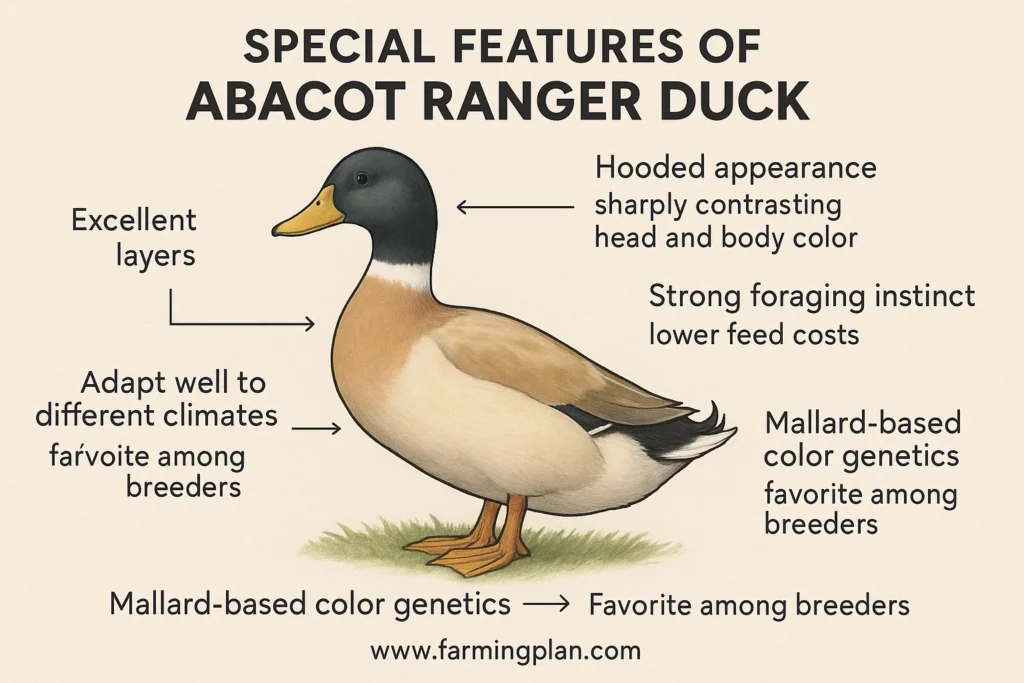The Abacot Ranger Duck is one of my favorite birds to raise on the farm. From their creamy-white bodies to their charming fawn-colored heads, these ducks are not just beautiful but also hardworking egg layers. Whether you’re a backyard hobbyist or a seasoned breeder, this breed has something for everyone. Developed as a light utility duck, the Abacot Ranger is a great all-rounder—excellent in egg production and equally tasty as a table bird. In this guide, I’ll share everything you need to know about raising Abacot Ranger Ducks, using my firsthand experience, expert insights, and easy-to-follow advice. Get ready to fall in love with one of the most underrated breeds in domestic waterfowl!

History & Origin of Abacot Ranger Duck
The Abacot Ranger Duck has a fascinating backstory. It was first bred in the United Kingdom during the early 1900s by Mr. Oscar Gray at Abacot Duck Ranch. By crossing White Indian Runner Ducks with Khaki Campbells, he created a light utility duck that quickly gained popularity due to its excellent laying ability and elegant looks.

Interestingly, while the breed lost traction in Britain mid-century, it was preserved and improved in Germany under the name “Streicherente” (German for “Ranger Duck”). The German bloodlines added vitality and strength, and eventually, British breeders re-imported the breed. Today, it’s a respected choice for both practical farms and show pens, thanks to its stylish appearance and dependable performance.
Read More: Classifications of Poultry: Proven Strategies for Successful Farming
Characteristics of Abacot Ranger Duck
The Abacot Ranger Ducks stand out with their unique and elegant build. These medium-sized birds boast creamy-white bodies and a fawn-colored or greenish hood. Their heads are often richly colored—either deep reddish-brown or green—and they usually have a well-defined silver or white neck ring, adding to their captivating appearance.
Their bill is typically olive-green, and the feathers on their primary and secondary wings show subtle variations depending on the bird’s mallard gene expression. These ducks show strong mallard-type markings, often with streaked bodies and creamy breasts. Their upright posture, inherited from Runner Ducks, gives them a lively, alert appearance. They’re not just good-looking—they’re practical too, especially in terms of egg laying and active foraging, which will surely reassure you of your choice.
Nature & Temperament of Abacot Ranger Duck
I’ve always appreciated the Abacot Ranger’s temperament. These ducks are calm, friendly, and curious—perfect for both small farms and family backyards. They are not aggressive and can be easily handled. While they enjoy human interaction, they also love to roam freely, foraging for bugs and greens. They’re not noisy like some breeds, making them ideal for more populated areas.

They mix well with other light duck breeds like Khaki Campbells and Silver Appleyards. However, they do best in small flocks where their playful nature shines. Abacots don’t mind colder weather and remain active year-round. If you have space for free-ranging, you’ll find these birds busy exploring every inch of the area.
Food & Diet of Abacot Ranger Duck
When it comes to diet, Abacot Rangers are not picky, but they do need balanced nutrition. I usually start ducklings on a high-protein starter feed (20-22%) for the first 3 weeks, then gradually shift to a grower feed (16-18%). For adult ducks, a layer pellet or all-flock feed works perfectly.
Always provide clean, fresh water, especially when feeding dry grains. Supplement with greens, peas, oats, and even small insects or mealworms. Avoid giving moldy food, bread, or anything salty. Abacots love to browse, so letting them forage in grassy areas improves their health and egg quality. A balanced diet is key to their well-being and productivity.
Usage & Purpose of Abacot Ranger Duck
The Abacot Ranger is one of the best dual-purpose ducks around. They lay around 180–220 eggs per year, with excellent-sized duck eggs that are perfect for baking. Their productivity is on par with more commercial breeds like the Khaki Campbell. This high egg production makes them a valuable addition to any farm or backyard.
Besides laying, they also make decent table birds. While not as heavy as Pekins or Muscovies, their meat is tender and flavorful, especially when raised on pasture. For hobbyists and breeders, their stunning looks also make them a hit in poultry exhibitions and shows.
“A Duck With The Looks Of A Showbird And The Grit Of A Farmhand—That’s The Abacot Ranger!”
Special Features of Abacot Ranger Duck
There are quite a few traits that make Abacot Rangers stand out. One is their hooded appearance—that sharply contrasting head and body color makes them truly eye-catching. Another is their strong foraging instinct, which means lower feed costs for free-range farmers like me.

They’re excellent layers, weather-hardy, and easy to handle. I’ve also noticed they adapt well to different climates and living environments, which should give you the confidence that you can raise them successfully in various conditions. Their unique mallard-based color genetics make them a favorite among breeders experimenting with duck coloration.
Read More: Arzamas Goose: Legendary Icon of Russian Heritage
Health Issues & Prevention of Abacot Ranger Duck
Like any breed, Abacot Rangers can face health issues. The most common include respiratory infections, parasites, and bumblefoot. I recommend regularly checking their feet for cuts, especially if they roam on rough terrain. Clean bedding and dry shelter are essential to avoid mold-related respiratory issues.
Routine deworming every few months and keeping feed dry and fresh prevents most digestive problems. Always isolate any sick duck immediately. Provide access to clean water for swimming and cleaning—dirty feathers can lead to oil gland blockages.
Step-by-Step Farming Guide of Abacot Ranger Duck
Step 1: Prepare The Housing
Start with a dry, predator-proof coop with good ventilation. I use wood shavings for bedding and clean it weekly. Ducks need about 3-5 square feet per bird indoors and 10-15 square feet outside. Include a secure run and shaded spots.
Step 2: Brood The Ducklings Properly
Keep ducklings warm under a brooder lamp for the first 3-4 weeks. Start at 90°F and reduce by 5°F weekly. Provide shallow water dishes to avoid drowning. Use non-slip flooring to prevent leg injuries.
Step 3: Transition To Grower Setup
At 4-6 weeks, move them to a grow-out pen with space to forage. Introduce them slowly to greens and bugs. Watch for signs of cold stress or illness during this transition.
Step 4: Feed & Water Routines
Stick to a morning and evening feeding schedule. I offer grain, layer pellets, chopped greens, and occasional treats like peas or worms. Clean water is a must—ducks love to dip their heads.
Step 5: Encourage Foraging & Activity
Let your ducks free-range daily, even if just a couple hours. It keeps them healthy and reduces feed needs. Provide kiddie pools or small ponds for splashing and cleaning.
Step 6: Monitor Health Regularly
Check eyes, nostrils, and feet weekly. Look for signs of mites or feather loss. Keep a basic duck first-aid kit: vet tape, antiseptic spray, Epsom salt, and poultry vitamins.
Step 7: Handle With Care
Abacots are friendly, but always handle them calmly and confidently. Scoop under the chest and support their feet. Avoid chasing—it stresses them out.
Expert Tips & Best Practices From My Farm of Abacot Ranger Duck
- Let them free-range as much as possible to reduce feed bills.
- Use kiddie pools instead of digging ponds—easier to clean!
- Choose ducks with bright eyes and firm, straight legs when buying.
- Feed oyster shells separately for stronger eggshells.
- Introduce new flock members slowly to avoid pecking.
- Rotate pastures every few weeks to prevent overgrazing.
- Always keep their coop dry to avoid foot infections.
- Add apple cider vinegar to water weekly for gut health.
FAQs
Are Abacot Ranger Ducks good egg layers?
Yes! They lay about 180-220 eggs per year, which is excellent for a light duck breed.
Can Abacot Rangers live with other ducks?
Absolutely. They get along well with other light and medium ducks like Campbells or Runners.
Do they need a pond to be happy?
No, but they do love water access. A kiddie pool or shallow tub works just fine.
Are they noisy ducks?
Not really. They’re relatively quiet compared to many other breeds.
Can you keep them as pets?
Yes, their calm temperament and friendly nature make them great for families and hobbyists.
Conclusion
Raising Abacot Ranger Ducks has been one of the most rewarding parts of my farming journey. They’re attractive, productive, and easy to care for—ideal for beginners and experienced keepers alike. With their calm nature and reliable egg production, they fit well into backyard settings and small farms. Whether you’re breeding, showing, or simply enjoying the charm of ducks, the Abacot Ranger is a standout choice. If you’re thinking about starting with ducks, this breed could be the perfect beginning to your flock. Give them a try, and you might never look back!

